Hi, my name is Irene Gatti. I am a conservationist and field researcher. I had the privilege to stay in Ruam Thai village thanks to a research I became part of when I was working in a Big 5 reserve in the north of South Africa, aiming at studying the interaction between bee pheromones and elephants to try and create a natural barrier to prevent the elephants from walking into human settlements and causing damages.
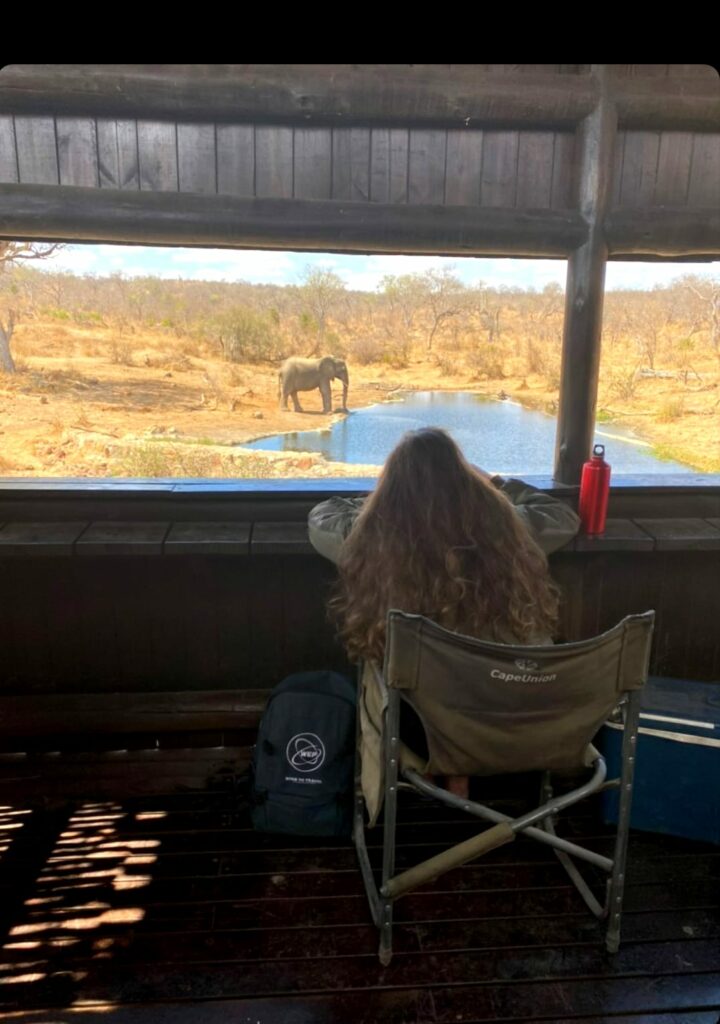
When bees are under attack (this, for instance, can naturally happen when an elephant forages or pushes over a tree with a beehive on it. Causing the bees to attack the elephants to protect their homes), they release certain kinds of alarm pheromones, that consequently have a specific smell to it. The idea is that by replicating that specific smell using some of the compounds of the alarm pheromones, the elephants would smell it and recognize the danger of it, backing off from the site. We are aiming for a calm and moderate stop-and-retrieve response.
It is important to state that elephants despite being the largest land mammal in the world, can be very sensitive, especially around the eyes, the ears, and inside the trunk. So being attacked by bees is most definitely not a pleasant experience for them either!
We aim for a less dramatic response from the elephants because we certainly don’t want an entire herd of elephants running for their lives…
This is overall the general idea of the research.
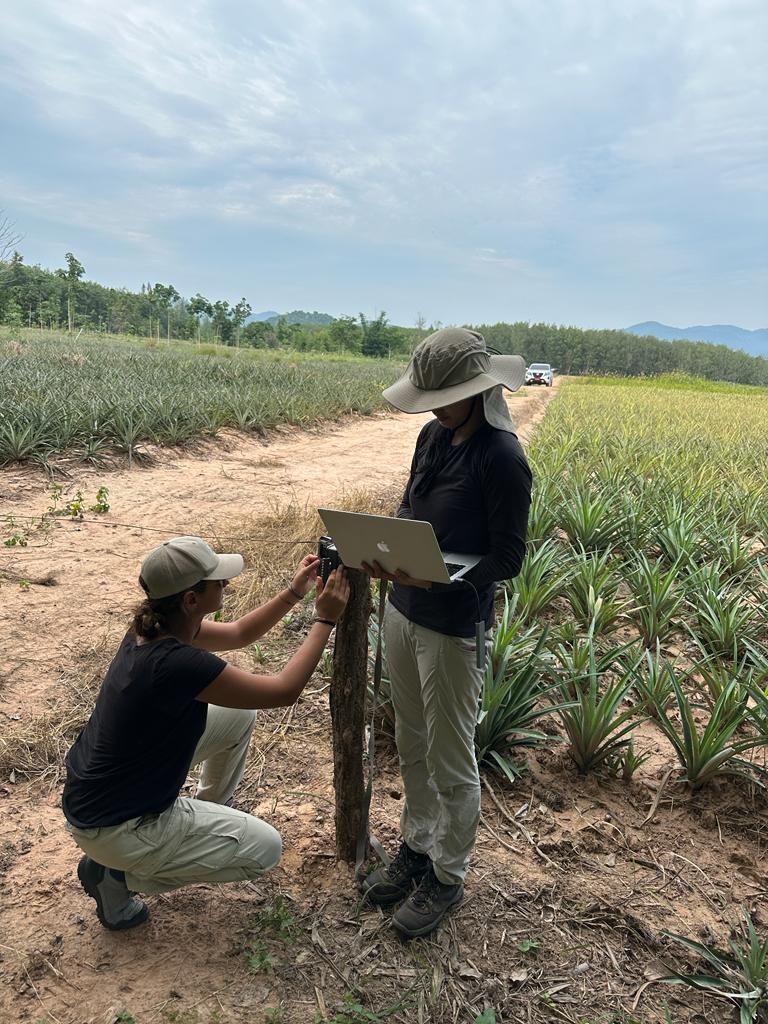
Dr. Mark G. Wright, professor and entomologist of the University of Hawaii is the brain behind this.
It has been a few years now that the data collection has been happening in South Africa, and there are some promising results so far.
On a South African winter evening, we started wondering how this study would impact Asian elephant’s behavior, as it has never been done in any Asian countries before. All we knew, was that in many villages people have to face the human-elephant conflict daily, trying to protect their crops and homes, and the pheromone idea might be something worth testing out.
After what seemed just a normal researcher’s wish, we actively started working on it and managed to make it happen, and a year and a half later we were heading to Ruam Thai village, in the Prachuap Khiri Khan province of Thailand, to test out the pheromones!
Through the NGO Bring The Elephant Home operating in Thailand, we were able to combine the pheromone research previously conducted in South Africa, with their beehive fence model research previously conducted in a different province of Thailand.
Our common goal is to understand which fence model is more effective in stopping elephants from walking into crops and hopefully reduce and/or prevent the big issue of human-elephant conflict that is going on in the area.
For a better general understanding, Ruam Thai is a very small village in Thailand, built on the edge of the National Park. It is surrounded by 40 km of unfenced Kui Buri National Park borders. Almost every night, elephants tend to break out of the NP borders, into crop fields for easy access to food and resources. The local farmers mainly farm pineapples, mangoes, jackfruit, rubber trees, and more…all very appealing to the delicate elephant’s palate.
When socks and science go well together
We found that socks are one of the easiest and most practical ways to deploy the experiment on the landscape! The pheromones are chemically produced in a lab and put into a paste-like substance. We then apply a small amount of this pheromone paste into a sock containing a rock (the rock inside is used to give a little bit more weight on the sock so that it can hang more easily), and here it is, ready to deploy!
Usually, we would deploy 2-3 socks containing pheromones, 2-3 socks containing formic acid (which works on the same principle as the bee pheromones, but it is produced by ants instead of bees), and 2-3 plain socks that are used as control. The control socks are crucial to determine and better understand if the elephants are reacting towards a specific smell, or just because of an unusual shape in the landscape.
We use socks not just because they are easy to hang on branches and trees, but they are also easily available almost everywhere, and they attract the elephant’s attention due to being a new addition to their natural landscape.
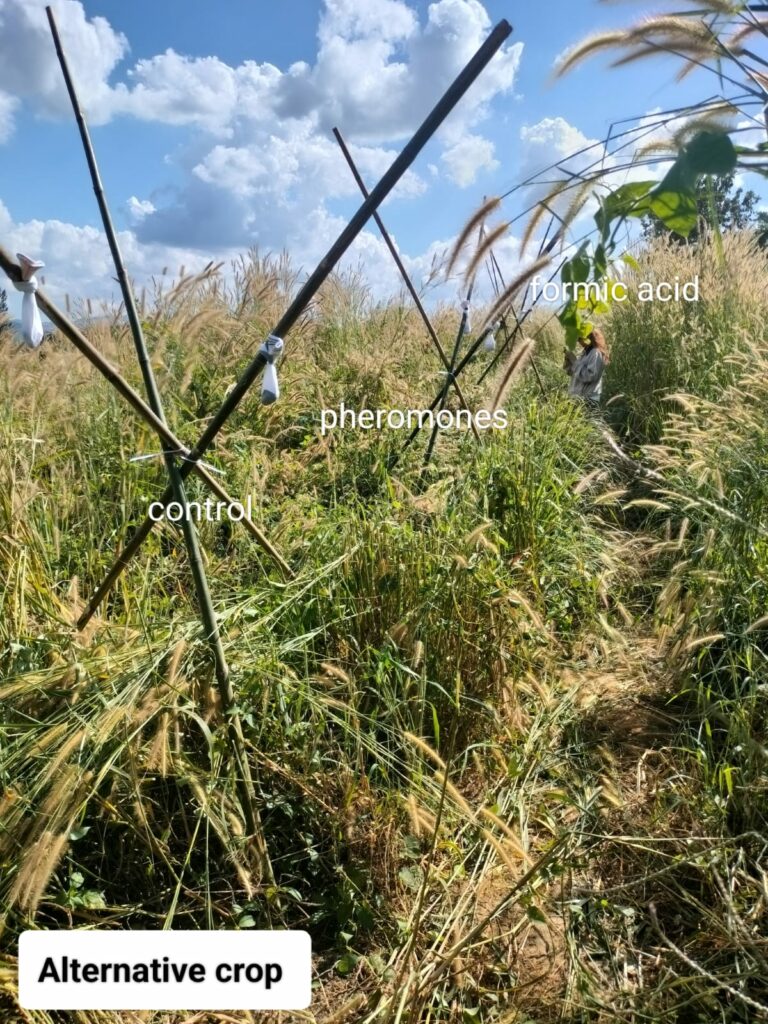
The Thailand approach turned out to be quite different from the South African one, due to the difference in elephant’s behavior and the difference in the areas we have access to.
In South Africa we work inside the Park, doing live observations around waterholes. We would start early in the morning, deploy the pheromones, formic acid, and control sock in a fairly systematic way around the waterhole, and wait for the elephants to come and observe and analyze the interactions.
In Thailand, this approach is not quite possible. It is not easy to have such free access to the National Park, so we are relying on working on the borders, deploying the experiment where we can see elephants’ pathways. But because of this, we have to rely on camera traps to capture the elephant’s interactions, because the elephants tend to cross the borders at night time. Additionally, the landscape isn’t as “branches friendly” as the South African ones, so we created bamboo structures to hang the socks on, as can be seen in the picture.
Despite Ruam Thai being a very remote area, interesting adventures never lack!
Here are a couple of remarkable moments and memories.
How to leave a mark
First things first, for anyone who is not familiar with it, life in the field can be challenging and more often than not requires good skills of adaptation.
In my case, one of my first challenges was to figure out an effective way how I could transport my pheromones and formic acid into the field. The new mode of transportation makes it look like a big gun/rifle-looking shape, long and very unbalanced.
So while talking to a couple of people working for BTEH, there was an interesting idea rising “Why don’t you get some straps and attach it to the gun to be able to carry it like a yoga mat?” said Ave. Brilliant idea, and so I did. I used some camera trap straps, attached them to the pheromone guns, and it turned out it makes you look like a Tomb Raider character, carrying their guns strapped onto the back!
To even make it more interesting, I started cycling to my sites. So whenever I had to refill my pheromone supplies out in the field, well…it looked pretty hectic!
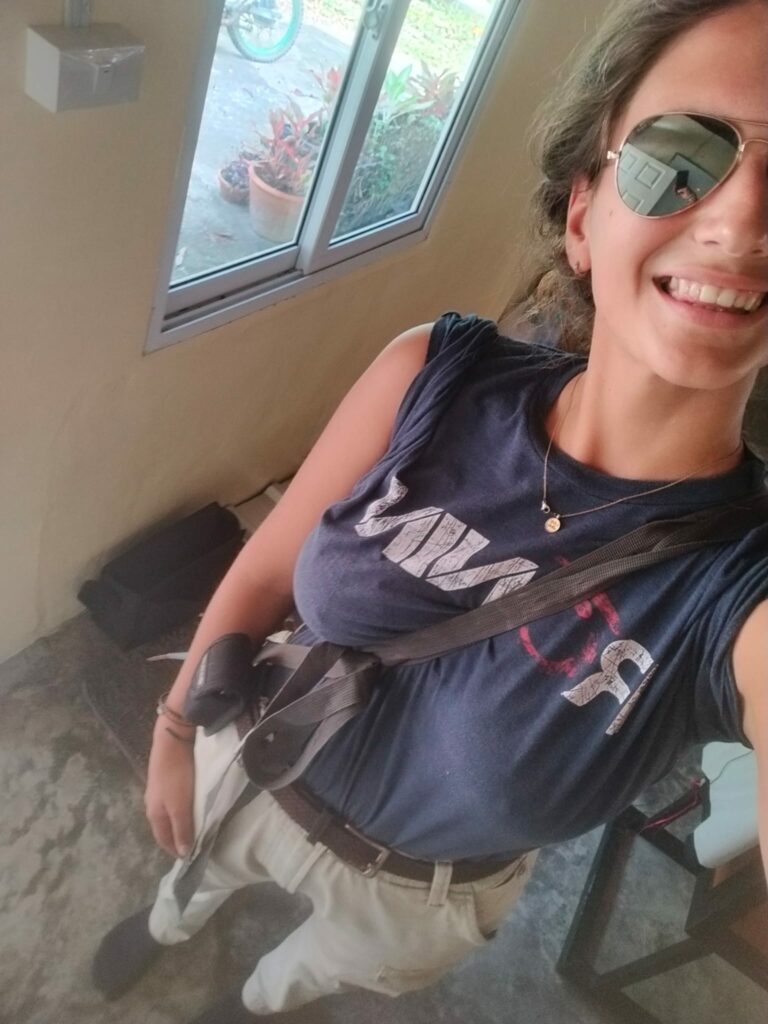
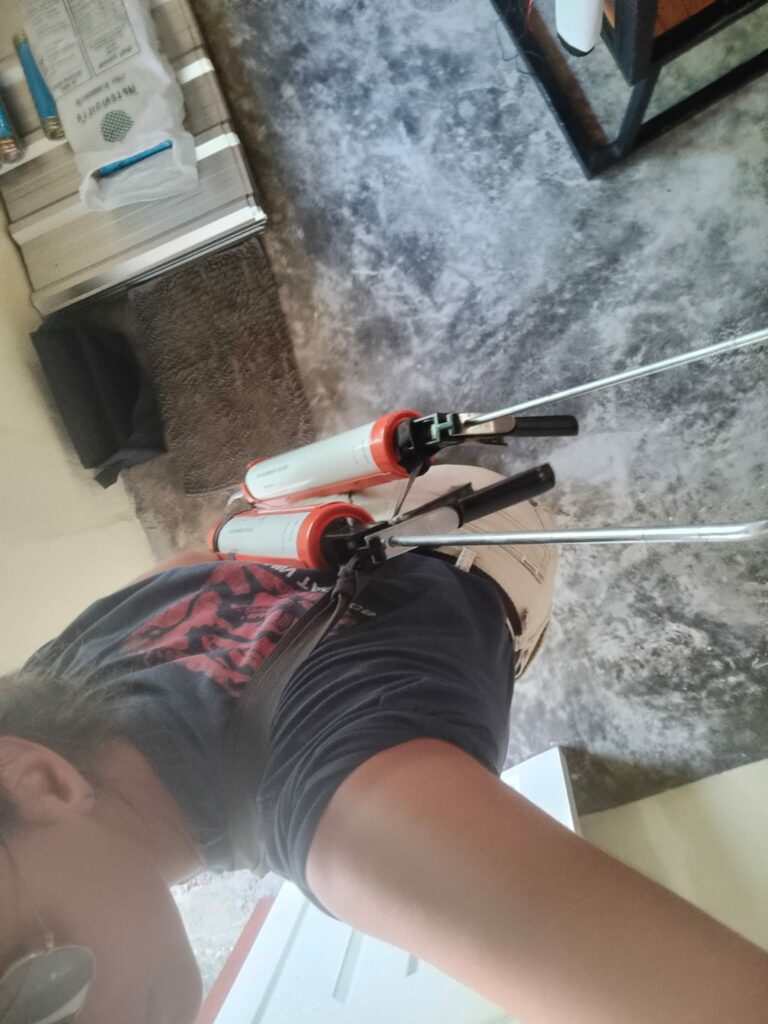
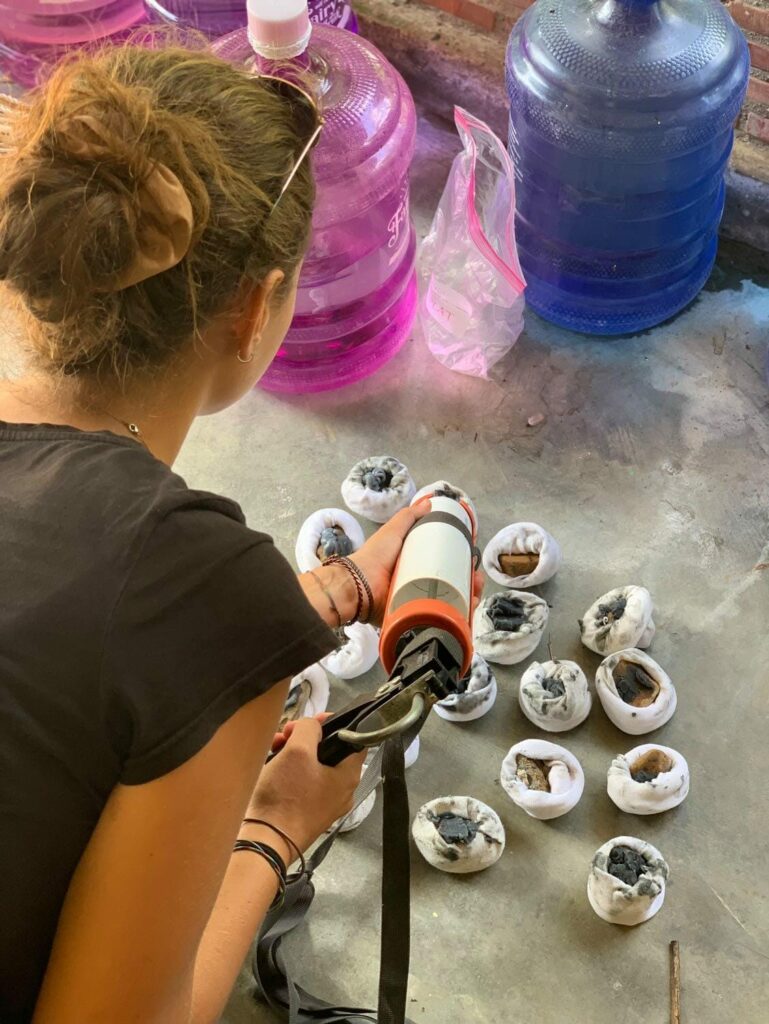
Nam Jai of colleague turned into natural lip filler
Nam Jai is by far my favorite Thai word so far, it directly translates to ‘water heart’. If you have nam jai means you have generosity of the heart.
One day in the field, Tyler, an American researcher working for BTEH, had an unfortunate event. Trying to remove their camera traps and solar panels, came across a hornet’s nest. The hornets did not appreciate the disturbance and attacked. Tyler returned to the office with a couple of stings, and unfortunately no solar panel! Hearing the story, and always craving for a little adrenalinic adventure I offered my help to try and retrieve the solar panel.
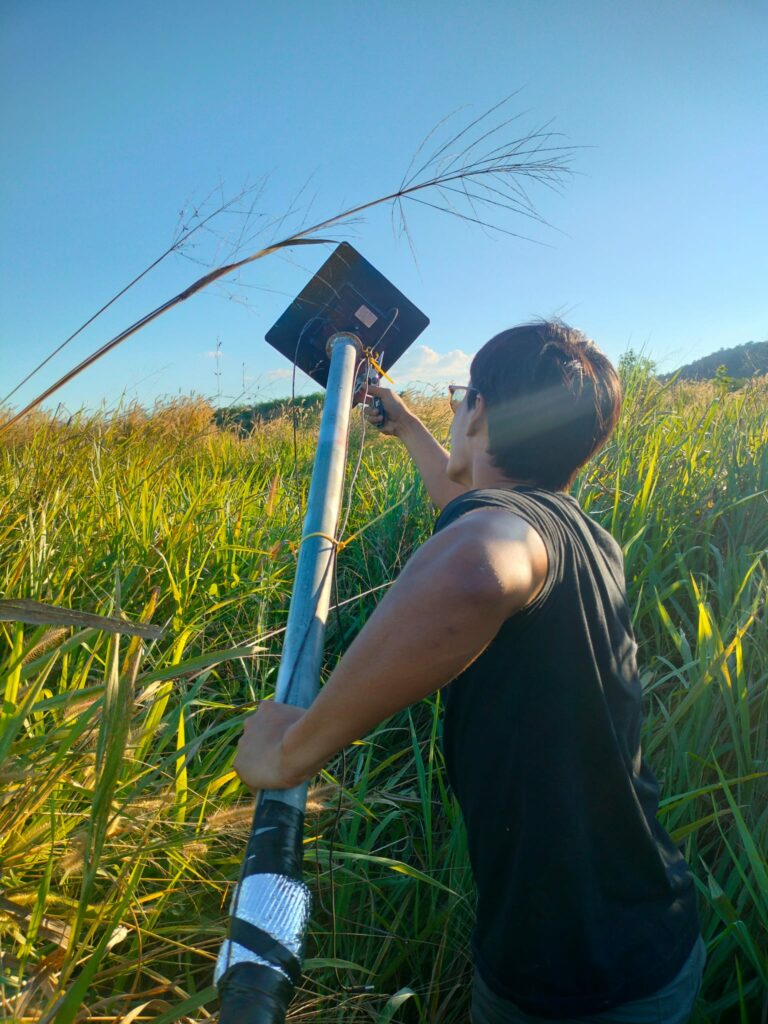
A couple of hours later, I was on my way to this new exciting adventure, with Phum, Tyler’s research assistant. We honestly had no idea what we were walking into, but it was part of the fun!
After locating the solar panel in a grass field (with grass as tall as us to make it more entertaining obviously) we started making a plan.
We reached the solar panel, which was way up high on a steel pole. We both agreed to move slowly to avoid upsetting the hornets and we started operating. Removing and cutting cables etc.
Everything was proceeding fairly smoothly, with a couple of panic laughs, but those were good for the soul for sure. Until it was time to remove the big steel cable used to secure the solar panel to the pole.

I told Phum I was going to try and pull it slowly, but we had no guarantee of not upsetting the wasps, who by now were looking straight at us!!
It was working well until the last bit of the cable arrived. It was bent at the end, making it impossible to remove slowly.
I warned Phum I was going to pull it hard and to be prepared to duck down and cover his face. But apparently, the message was sent but not received as he still claims I did not tell him!
I proceeded to pull and ducked down immediately. In a split second, I hear Phum spitting on the ground and shouting “It’s in my mouth!!”. I, confused, turned towards him. And oh boy, he didn’t duck down fast enough, the hornets went straight for him and stung him right on his upper lip!
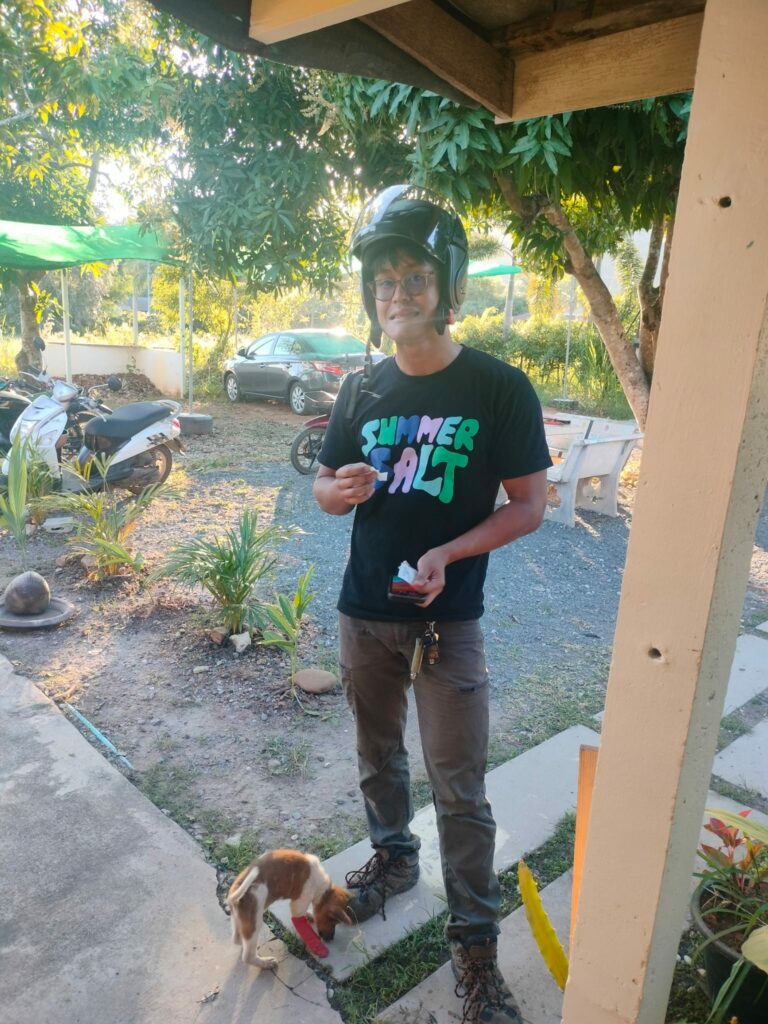
Past the second of pain, he started laughing, and I started laughing. We decided it was probably best to make a different plan, and we made our way back to the car still laughing.
By the time we arrived at the office, his lip was already starting to swell majorly!
We ended up grabbing some toilet paper, soaked it in with cooking oil, attached it to the extremity of a bamboo stick, went back to the solar panel, lit it up, and the hornets were gone in no second. That’s how we were able to remove it safely.
This last method turned out to be way too easy…
But long story short, Phum’s lip kept on getting bigger and bigger….only the upper lip!
It properly looked like he had Botox done! It even remained that way for a good 3 days!
P’Sak the bee whisperer
P’Sak is a very well-known gentleman of the village. He runs the beekeeping group, and he has been helping us out on the beehive and pheromone fences. It’s unfortunate that there is a language barrier, and to communicate with him there is the need for a translator, but he is a very kind soul.
P’Sak was called from the local school to remove a wild Apis Cerana bee colony. And why not join in this exciting adventure?
So, on a mid-Saturday day, P’Sak, Miew (my research assistant and great translator), and I, all met at the local school to remove the wild colony.
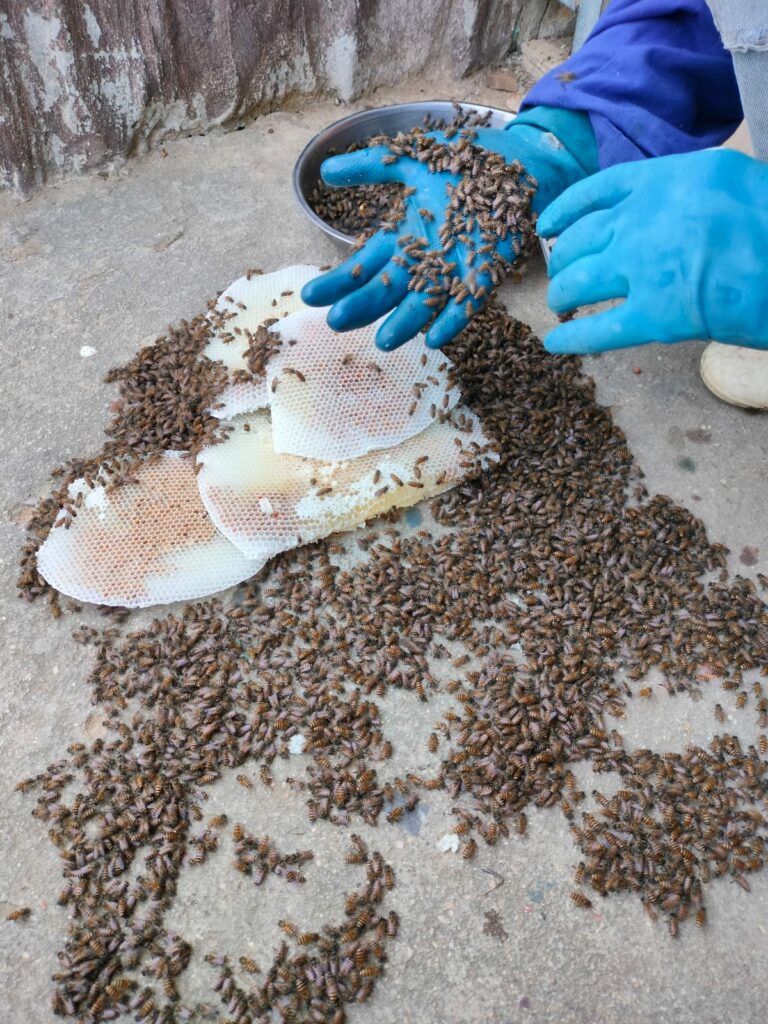
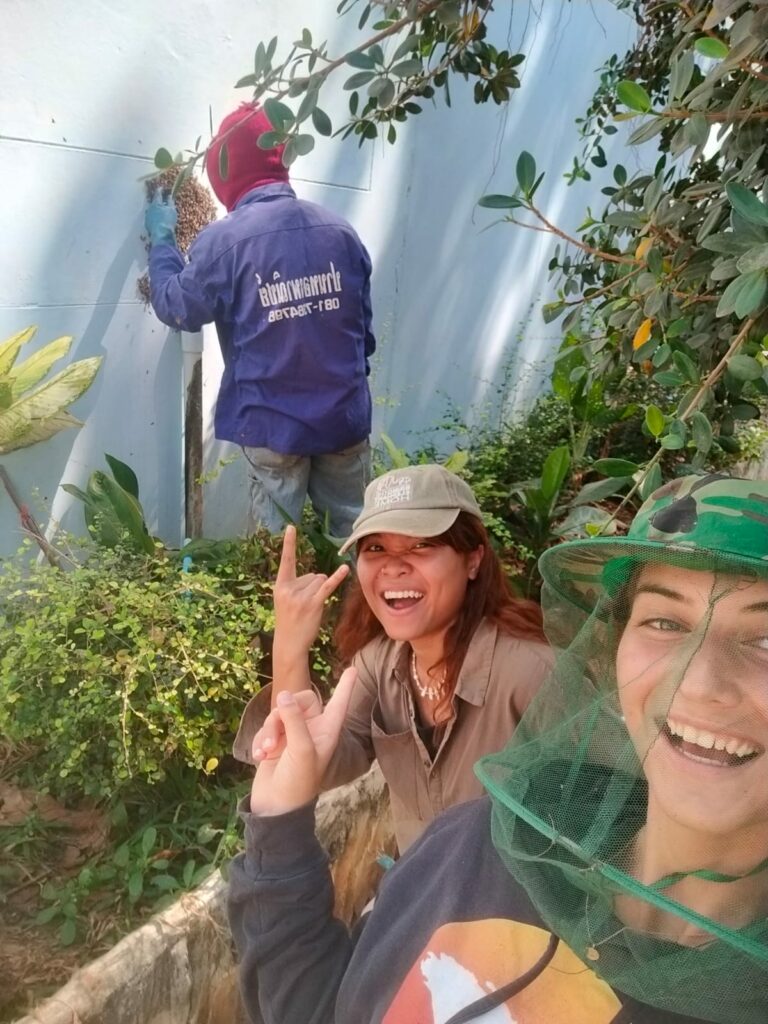
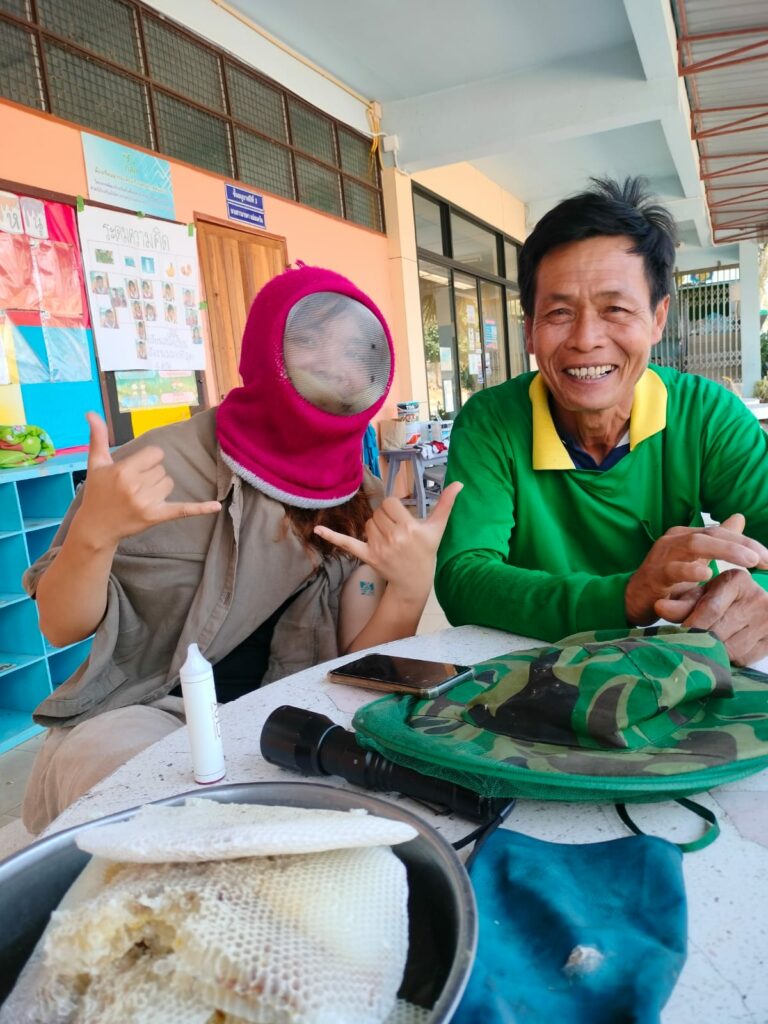
Bear in mind, neither myself nor Miew has ever done such a thing!
The colony was inside a little tiny dark storage room, and it was a big colony! At least 3000 bees in it. Of course, to make it more ‘entertaining’ we didn’t have professional fancy beekeeping protections as they are seen on television. We tried our best to be as covered as possible, even if that meant wearing a winter sweatshirt in 35 °C weather.
We ventured inside the room, and P’Sak showed off awesome beekeeping skills!
He sliced the comb piece by piece, looking for the queen.
Our goal was to find the queen and transfer her into one of our human-made beehive boxes to create a colony for the beehive fences.
He showed us the difference between worker bees and male bees, and what the queen is supposed to look like.
Despite being a slightly scary experience, with thousands of bees swarming around us and walking on us, it was a very educational experience as well!
Unfortunately, he wasn’t able to locate the queen, but what an adventure!
Bees are such intricate and interesting animals.
Desperate times call for desperate measures
The heat…ah the heat. It is bearable by some, but can make others struggle majorly!
It is January, and the heat has already some of the people struggling. The office can become an oven during the hottest parts of the day. And with Thailand’s climate being highly humid as well, it can be felt quite heavily at times.
The BTEH office has been using a roof sprinkler system to rapidly cool down the office in such situations, but lately, even that system doesn’t make much of a difference!
The office is also filled with fans to try and move some air, but it still keeps a good and toasty temperature inside.
As people say, desperate times call for desperate measures, so one day some staff members came up with the idea of putting net shedding on the rooftop, to try and make some sort of a difference.
Therefore, one afternoon the adventure began!
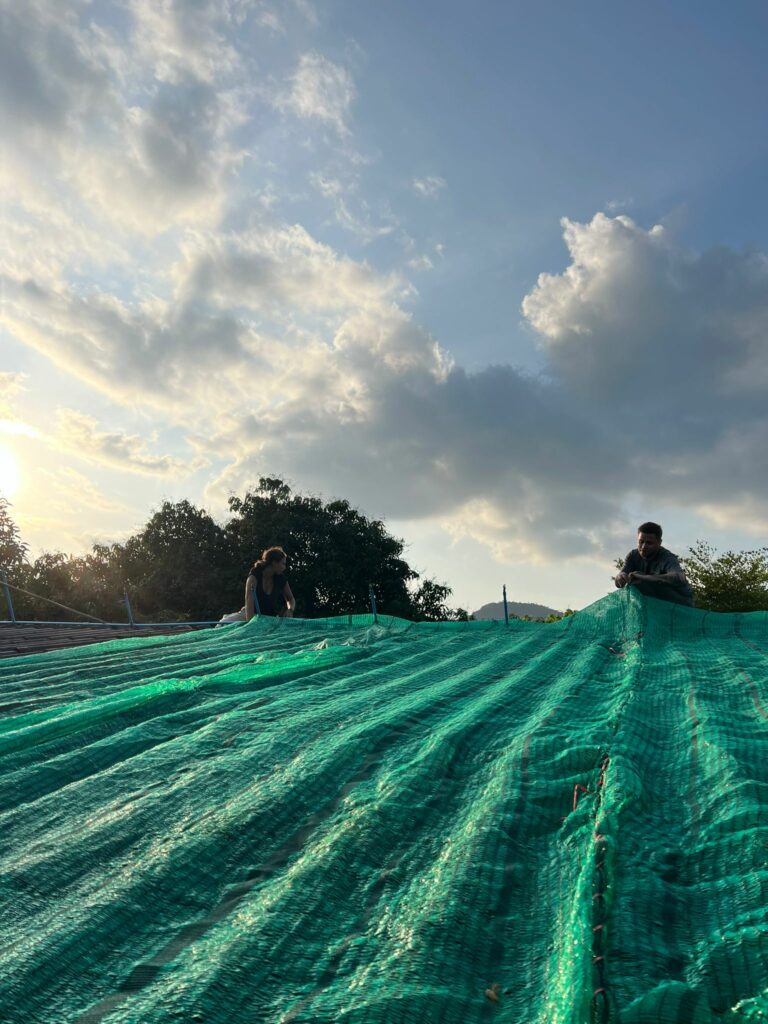
They already had a big piece of netshed lying around, so first we untangled it.
The next step was to put it on the rooftop…easier said than done!
Tyler and I climbed on top of the roof and made our way all the way up. While the people on the ground passed us the huge piece of netshed that kept on getting stuck in between the tiles.
The rooftop also isn’t really made for walking, and made funny scary sounds at times, keeping us constantly on edge.
It was very entertaining for us, full of slight panic laughs here and there, and we were definitely keeping the neighbors entertained!
Also, while we were up there, we activated the sprinkler system to make sure it was working properly. Which was fun, because it made us soaked, but it turned the whole rooftop into a slipper show!
We both safely made it back on the ground, but despite the mission of putting up the net was fairly successful, the end result didn’t make much of a difference…
But hey no worries, if you are planning on coming here you will be treated with a very nice AC system that’s already on the way!
Back to research talk
Adventures are all fun and games, but let’s not get distracted by why I got here in the first place.
The research is going differently than what we are used to in South Africa. Wildlife encounters aren’t as frequent due to the research being deployed just outside the borders of the National Park and not deep in the park like in the African savanna.
This reduces our chances of getting data and footage of the elephants interacting with pheromones, formic acid, control, or live beehive fences.
But let’s not be discouraged! This research will go on until the end of the year 2024, making it a one-year overall study. In this time, hopefully, we will manage to get enough data to determine how Asian elephants interact with our bee-based fences, and hopefully, it can become a sustainable solution for local farmers who face this issue daily.
The final prototypes for our fence models
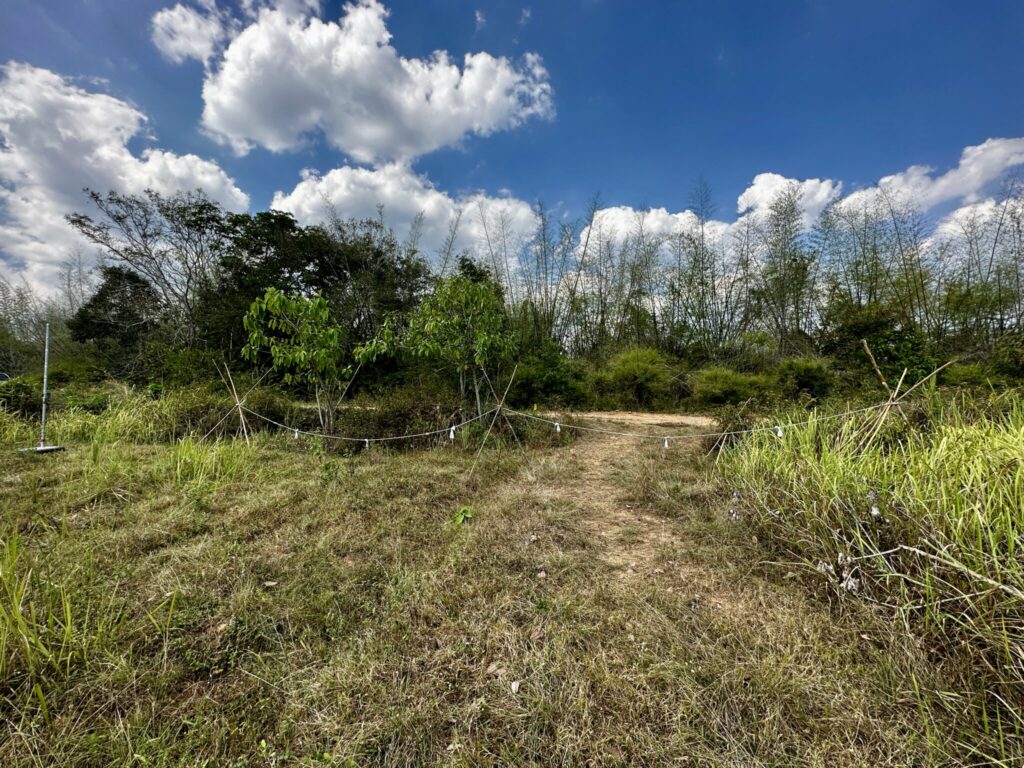
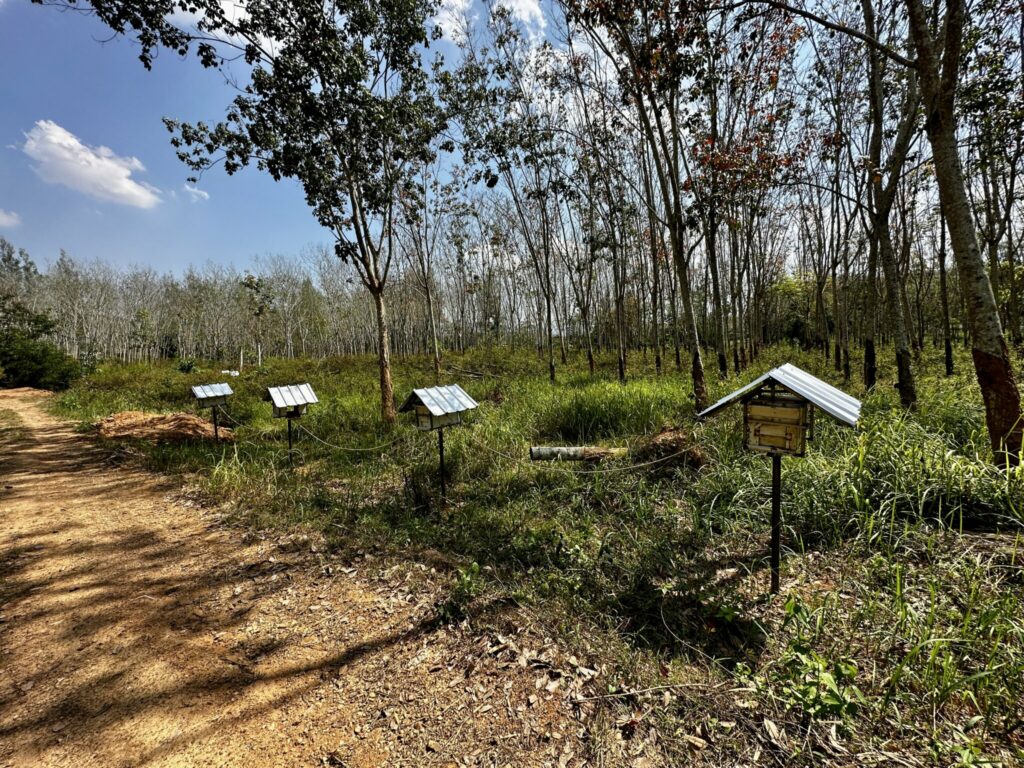
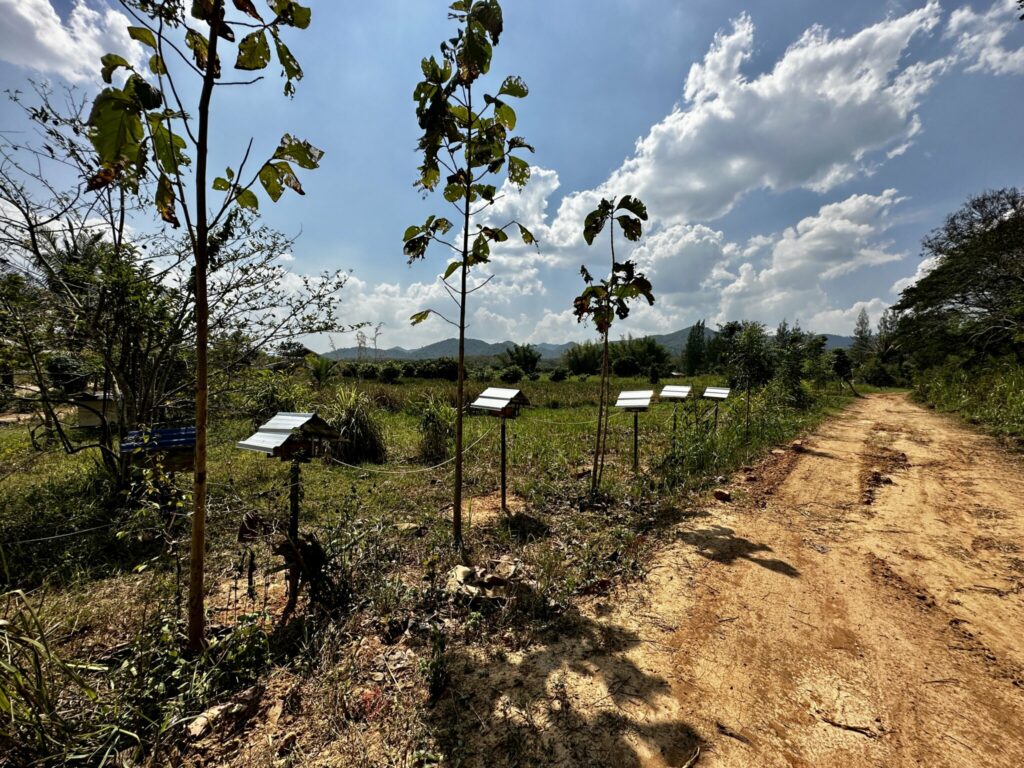
This hereby is the prototype model based on how the beehive poles and boxes are created for both the Cerana colonies and the Stingless bee colonies.
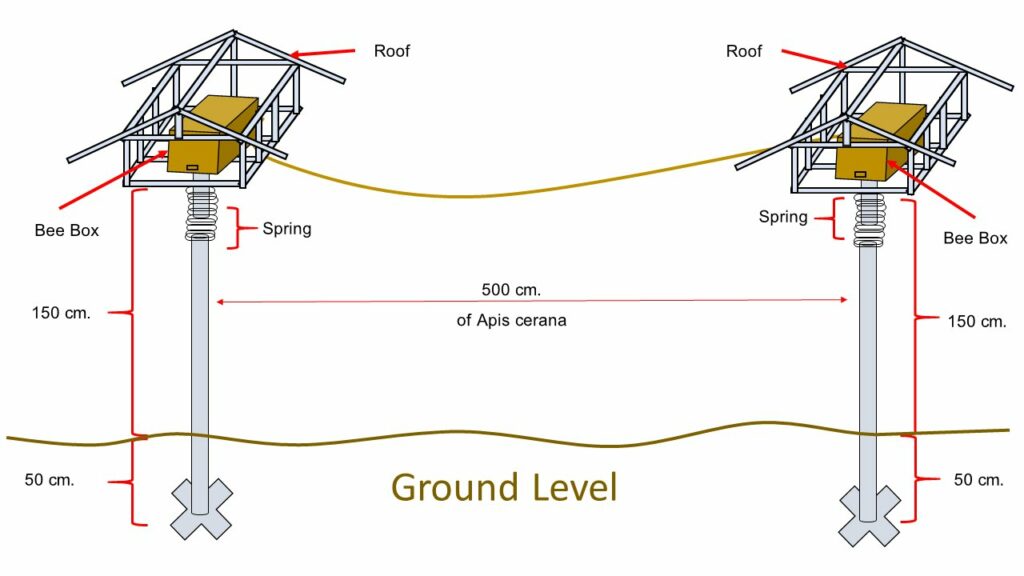
The Cerana boxes are also added with a trap door mechanism, by which, when the rope is pulled by the elephant, it will automatically open the door of the hive, freeing the bees. This is made to enhance the possibilities of the bees defending their hives and attacking the elephant.
The spring at the top of the pole is created to provoke an oscillating mechanism of the whole beehive when the rope is moved which is also made to agitate the bees when a disturbance occurs.
Having live bees helps our original pheromone research. This happens because, if the elephants have no previous encounters with bees, then most likely they will not associate the smell of the pheromones with danger. Deploying live bees on the landscape can be an effective method for conditioning the elephants to the pheromone smell!
As the research progresses, we hope to determine which fence model is more effective for preventing the elephants from walking into crops and damaging the farmer’s land.
Example of an elephant encountering a pheromone fence:
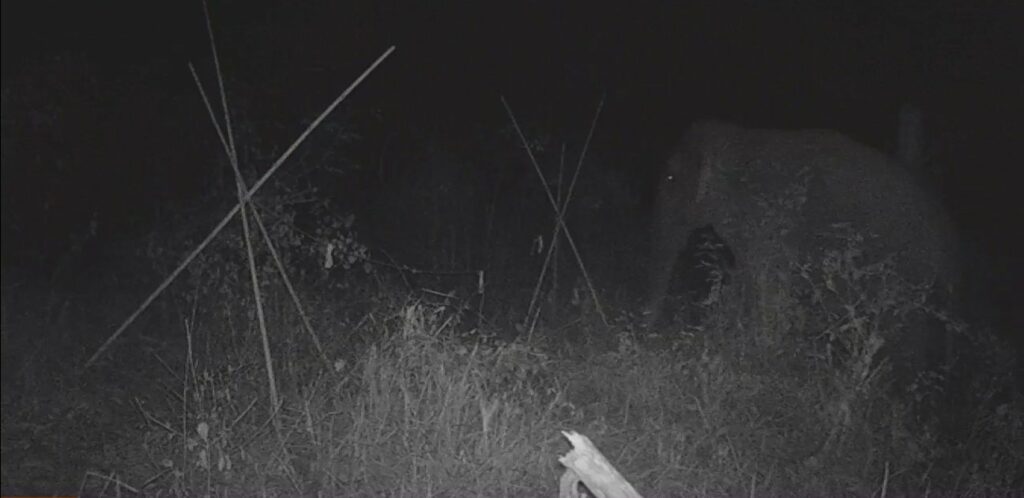
This picture is taken from a camera trap video, seconds before the elephant powers through the fence, knocking it over. It is important to note that this specific elephant was on his way back into the National Park after a night out foraging. Being unbothered by the pheromone smell can be due to the pressure of going back into the park before sunrise, or it could also be pressured by the sound of motorcycles/rangers approaching.
In Kui Buri, rangers are frequently busy with night missions to push the elephants back into the protected areas.
This is just one example, our goal is to capture as many elephant-fence encounters as possible to be able to determine all their behavioral responses.
Wish us luck!! And I hope to keep you updated on some exciting news! 🙂
Irene Gatti
‹ Back to previous page